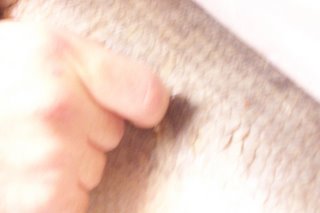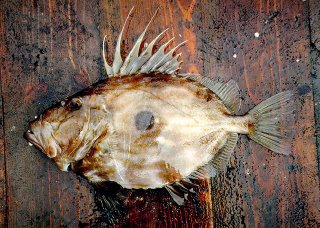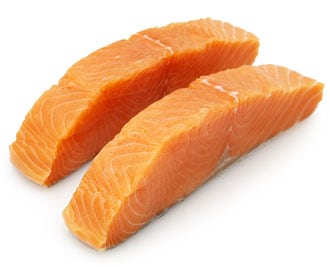 An Analysis of Kaskeses – past and present
An Analysis of Kaskeses – past and present
Rabbi C. Goldberg
HaModia, March 22, 2006(Caption: Checking the scales of a Burbot [Amia Calva])Consumers are becoming more health conscious. Fish is often considered a healthier option compared to meat. We are all familiar with certain fish like salmon and tuna. Yet, some may want to broaden their culinary experiences and try some more exotic varieties of fish. The question then becomes, what fish are kosher? This article will illustrate that it may not always be so simple to answer this question.
The Pasuk in Vayikra 11:9 describes a kosher fish as one that has “snapir v’kaskeses”, which is generally translated as fins and scales. From the Pasuk alone, one might think that a fish needs to have both simanim in order to be kosher. However, the Mishnah in Niddah 59A (expounded in Chullin 66B) tells us, “kol sheyesh bo kaskeses yesh bo snapir”, that any fish which has “kaskeses” will automatically possess “snapir”. Accordingly, in order to determine the kashrus of the fish, it would not be necessary to look at whether a fish has snapir. Instead, we simply need to confirm that it has “kaskeses”. The question remains, however, what exactly is “kaskeses”?
The Gemara discusses the definitions of “snapir” and “kaskeses”, and concludes that “snapir” refers to a fin that assists a fish in swimming, and that “kaskeses” refers to those finger-nail like protrusions on the side of a fish. The Gemara asks (in light of the knowledge that every fish possessing “kaskeses” automatically has “snapir”) what the was need for the pasuk to mention “snapir”. The Gemara responds, “Yagdil Torah V’Yadir”, that the pasuk mentions “snapir” in order to “make great” and “aggrandize” the Torah.
So, what exactly is “kaskeses”? Though it is often translated as “scales”, not all scales are included in the term “kaskeses”. The Ramban in Chumash tells us that a “kaskeses” must be able to be removed from the fish either by hand or with a knife, without ripping the underlying skin. Practically speaking, if the scale underneath the skin would rip upon removing the scale, the fish could have “fins and scales”, but not have “snapir v’kaskeses”, and it would not be kosher. The Ramban’s requirement is discussed in the Achronim
[1], but is universally accepted as the halacha (see glosses of the Ramah on Y.D. 83 in the name of Maggid Mishnah).
The Poskim do not require that a kaskeses must have a particular shape, color or texture. Any scale that can be removed without ripping skin would qualify as a “kaskeses”. The only limit discussed is the size of a scale, namely that it must be large enough to be viewed by the naked eye. Both the Aruch HaShulchan and the Tiferes Yisroel mention that the kaskeses must be perceivable by the naked eye from a normal distance in order to be halachicly significant. A single “kaskeses” anywhere on the fish, appearing at any point during its lifetime is sufficient for it to be kosher. Even if the “kaskeses” fell off before the fish was caught or if the fish had yet to grow a “kaskeses” (but is of a species known to grow “kaskeses” later in life), the fish is still kosher.
[2]Applying the definition of kaskeses to the various species of fish is not always simple. Some claim that one can look at the scientific classifications of scales in order to determine whether the scale qualifies as a kaskeses. Scientifically, there are five different types of scales: placoid, cosmoid, gadoid, ctenoid and cycloid. Placoid scales are found on many different types of sharks (sharks do have scales, though they rip the skin when removed and thus cannot be considered “kaskeses”), cosmoid are found on lungfish, gadoid are found on sturgeon, gars and bowfin. These three types of scales are rarely found on kosher fish, though I mentioned bowfin (Amia Calva) as at least one example of a kosher fish with gadoid scales. The other two types, cycloid and ctenoid scales, are the ones found on most kosher fish. The scale classifications are based on varying factors, such as the make up of the scale, its relationship to other scales on a fish, and the structure of the growth rings on the edge of a scale (experts can determine how old a fish is by counting rings on its scales, much as they would rings on a tree).
Some Rabbis have postulated that any fish bearing cycloid or ctenoid scales is a kosher fish. There are several reasons why one should disagree with this assertion. One reason is that some cycloid scales are not visible to the naked eye. For example a type of sand-eel (Ammodytes Americanus) is described as having cycloid scales. The author of this article showed the fish to various persons at a major kashrus agency, and no one there was able to see anything on the fish that was large enough to consider it as having “kaskeses”. Another reason why defining the type of scale is not sufficient to know if it is kosher, is that some fish have embedded scales. American Eel (Anguilla Anguilla) is known to have scales that could be “kosher” if not for the fact that they are deeply embedded into the skin. The same is true for burbot (Lota Lota). There is nothing intrinsic to the definition of any type of scale that requires it be able to be removed from the fish without ripping the skin, as is required for “kaskeses”. Therefore, looking at the scientific category of a scale is insufficient for purposes of identifying kosher fish.
Can a kosher fish list be constructed for the benefit of consumers? While kashrus agencies have compiled lists, many agencies no longer do that. Lists, however, are not a viable solution. The same common name can be used to refer to a myriad of different fish, some kosher and some not. Not all “cods” are kosher; the non-kosher burbot mentioned above is classified as a “gadidae”, technically making it a cod. Other examples include “torsk”, which can refer to both a kosher and a non-kosher fish, “escolar”(oil-fish) which also refers to multiple specimens of varying kosher status, and turbot where some are kosher and some not.
The Kaf HaChaim also sees common names as inaccurate. In his Sefer (Yoreh Deah 83:5), he notes that discrepancies between different Talmudic accounts of the “shibbuta” must lead one to conclude that there were multiple fish called “shibuta” in the times of Chazal.
To summarize, fish that have a kaskeses are kosher. The definition of kaskeses is unique to kashrus, and scientific classifications of scales are not halachicly determinative. A article describing practical applications will be IY”H forthcoming.
[1] See Shu”t Nodeh B’Yehuda Tinyana 26-29 where he discusses the possibility of soaking a fish in “mai afar” in order for the scales to be removed without ripping skin. See Pischei Teshuva S”K 1 who explains why this opinion is not accepted l’halachah.
[2] See Y.D. 83:1 and Ramah there who recommends one be machmir and require at least one “kaskeses” appear in one of three specific places on the fish – by the gills, tail or fin – based on a Tosefta.


 We here at Kosher Fish Destination have heard you, and we intend on updating regularly with a "Species Focus" on particular species of kosher repute. Feel free to e-mail me with your suggestions and requests, as well as any other thoughts about Kosher Fish Destination (especially if you enjoy the site or benefit from it). We love hearing from you!!!
We here at Kosher Fish Destination have heard you, and we intend on updating regularly with a "Species Focus" on particular species of kosher repute. Feel free to e-mail me with your suggestions and requests, as well as any other thoughts about Kosher Fish Destination (especially if you enjoy the site or benefit from it). We love hearing from you!!!











